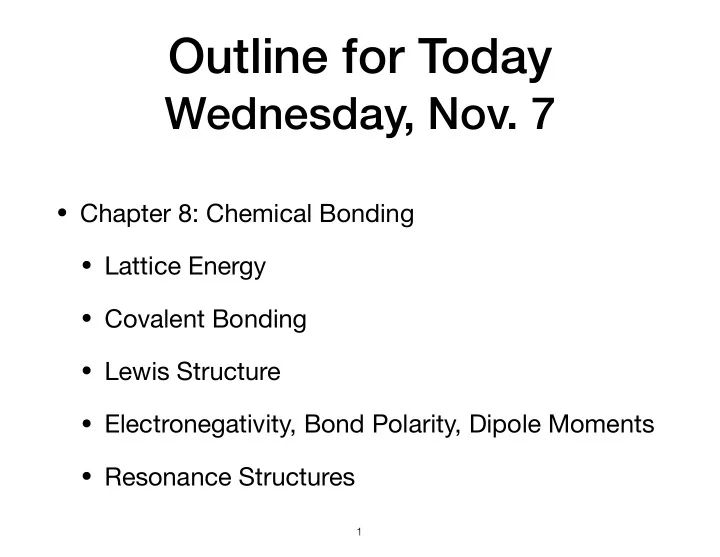

Outline for Today Wednesday, Nov. 7 • Chapter 8: Chemical Bonding • Lattice Energy • Covalent Bonding • Lewis Structure • Electronegativity, Bond Polarity, Dipole Moments • Resonance Structures � 1
Chapter 8: Basic Concepts in Chemical Bonding • Chemical Bond : When atoms or ions are strongly attracted. • Ionic Bond : Electrostatic forces (opposite charges) attract. Usually metal cations ionic bond to nonmetal anions. • Covalent Bond : Sharing of electrons, usually between nonmetals. • Metallic Bond : Each metal atom is bonded to many neighbors. Electrons are relatively free to move in the metal. � 2
Valence Electrons form Bonds between Atoms • Lewis Electron Dot Symbols help us keep track of valence electrons. • Octet Rule : Atoms will tend to gain or lose electron to become isoelectronic with the nearest noble gas. � 3
Ionic Bonding and Lattice Energy ∆ H rxn =+147 kJ/mol ∆ H f o =-788 kJ/mol � 4
Trends in Lattice Energy E electrostatic = κ Q 1 Q 2 d Li + : 0.9 Å Na + : 1.16 Å K + : 1.52 Å Cl - : 1.67 Å Rb + : 1.66 Å � 5
Procedure To Draw Lewis Structures 1. Count the total valence electrons . Include the overall charge. 2. Write the atomic symbols . Connect with single bonds. A. In polyatomic molecule the central atom is usually written first. 3. Complete octets around all atoms. A. Place any leftover electrons on the central atom. B. Not enough electrons? Try multiple bonds. � 6
Examples: Single bonds and Lone Pairs 6. Water 1. H 2 7. Cl 2 2. F 2 8. SH 2 3.CH 4 9. PH 3 4. Ammonia 10. HCl 5. Hydroxide 11. CF 4 � 7
Examples: Double Bonds 4. N 3- 1. CO 2 5. CO 2. N 2 6.CS 2 3. C 2 H 2 7.CH 2 O � 8
Electronegativity and Bond Polarity • Bond Polarity : Describes the extent of unequal sharing of electrons in a bond. • Nonpolar covalent : electrons are shared equally between atoms • Polar covalent : One atom attracts the electrons more than the other. • Electronegativity : Ability of an atom in a molecule to attract electrons. � 9
Electronegativity Trends in the Periodic Table � 10
Bond Polarity � 11
Dipole Moment: Separation of Charge Anion Charge: Cation Charge: Q=-1 Q=+1 Distance Between Charges: r Dipole Moment: � 12
Example: Bond Polarity 1. CO 2 4. NH 3 2. F 2 5. HF 3. C 2 F 2 6. CH 2 Cl 2 � 13
Formal Charge • Formal Charge: the charge each atom would have if each bonded electron is shared equally. F .C.= (# Valence Electrons)-(# Assigned Electrons) � 14
Examples: Double Bonds and Lone Pairs (Using Formal Charge) 1. HCN vs HNC 2. SCN 3. OCN 4. NO 2- 5. ClO 3- � 15
Procedure To Draw Lewis Structures 1. Count the total valence electrons . Include the overall charge. 2. Write the atomic symbols . Connect with single bonds. A. In polyatomic molecule the central atom is usually written first. B. Central atom is usually the least electronegative. 3. Complete octets around all atoms. A. Place any leftover electrons on the central atom. B. Not enough electrons? Try multiple bonds. 4. Check formal charges . Can rearranging electrons lead to formal charges closer to zero? � 16
On your group’s note card 1. Names of group members. 2. Write a 2-3 sentence summary of how to draw lewis structures. 3. Draw 1 picture or diagram that is important to understanding chapter 8.
Examples: Resonance Structures 1. Acetate ion 2. CO 32- 3. O 3 4. C 6 H 6 (benzene) � 18
Examples: Exceptions to the Octet Rule 5. Phosphate ion 1. XeF 4 6. SO 2 2. BH 3 3. NO 7. SF 4 4. PCl 5 8. I 3- � 19
Bond Strength and Bond Enthalpy Bond Enthalpy: The enthalpy required to break a one mole of a particular bond in the gas state. ∆ H rxn = ∆ H bonds broken - ∆ H bonds formed � 20
Recommend
More recommend